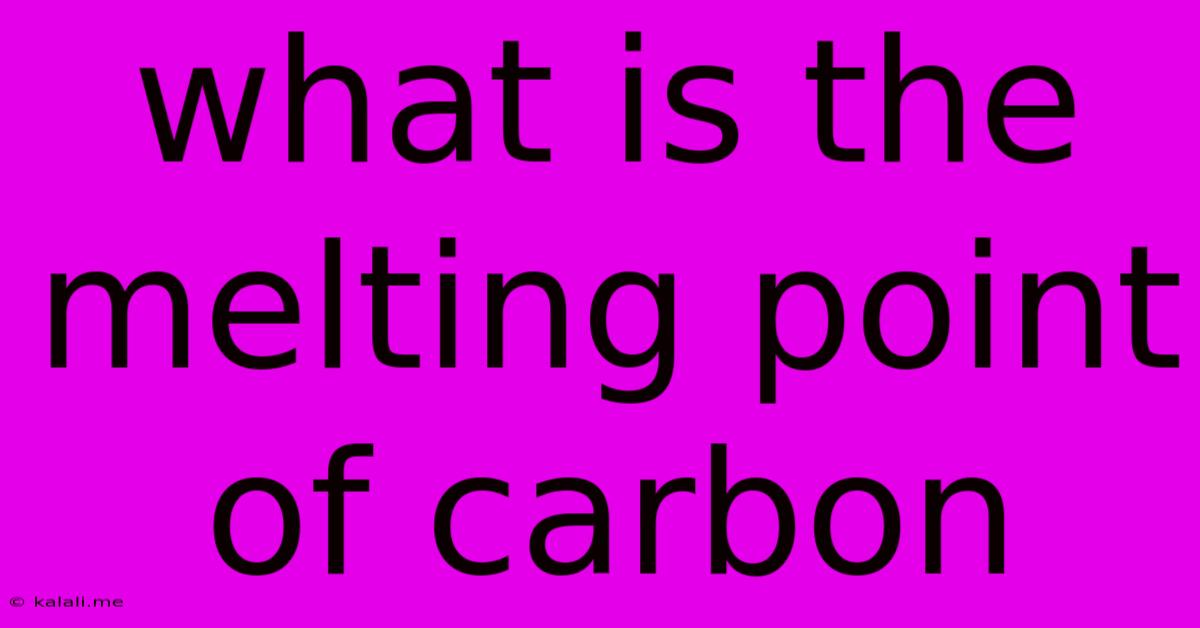What Is The Melting Point Of Carbon
Kalali
Jun 14, 2025 · 3 min read

Table of Contents
What is the Melting Point of Carbon? A Deep Dive into Carbon's Unique Properties
Meta Description: Discover the fascinating complexities surrounding carbon's melting point. Learn why it's so difficult to define and explore the different forms of carbon and their unique behavior under extreme heat.
Carbon, the backbone of life and a cornerstone of modern materials science, presents a unique challenge when it comes to determining its melting point. Unlike most elements, carbon doesn't have a single, easily defined melting point. Instead, its behavior under high temperatures is significantly influenced by its allotropic forms – the different structural arrangements of its atoms. This article delves into the intricacies of carbon's melting point, exploring the reasons behind its complexity and examining the melting points of various carbon allotropes.
The Challenge of Defining Carbon's Melting Point
The difficulty in defining a precise melting point for carbon stems from its strong covalent bonds. These bonds are incredibly robust, requiring an immense amount of energy to break. Furthermore, under extreme pressure and temperatures required to melt carbon, it tends to sublimate – transitioning directly from a solid to a gas – rather than melting into a liquid. This makes direct observation of a melting point extremely difficult.
Graphite: A High-Temperature Sublimator
Graphite, the most common allotrope of carbon, is famously known for its layered structure. This structure contributes to its relatively low melting point compared to other allotropes, though it's still incredibly high. Under standard atmospheric pressure, graphite doesn't melt. Instead, it sublimes at approximately 3652 °C (6606 °F). However, under extremely high pressure, graphite can melt. The exact melting point under pressure is still a subject of ongoing research, with estimates ranging from 4000-5000 °C.
Diamond: The Unsublimable Giant
Diamond, another well-known allotrope, boasts a three-dimensional network of strong covalent bonds, making it exceptionally hard and resistant to heat. Like graphite, diamond also sublimes before melting under standard atmospheric pressure. Its sublimation temperature is even higher than graphite's, starting around 3550 °C (6422 °F). Similarly to graphite, experimental determination of the melting point is incredibly challenging, and the precise melting point under high pressure remains elusive, with estimates in the range of 4000-4500°C.
Fullerenes and Carbon Nanotubes: A Different Story
Fullerenes (like buckminsterfullerene or "buckyballs") and carbon nanotubes represent a relatively new class of carbon allotropes. Their unique structures lead to different properties, including lower melting points compared to diamond and graphite. However, even for these structures, precise melting point determination remains challenging due to their susceptibility to decomposition at high temperatures before actual melting occurs. Furthermore, their melting points can vary significantly depending on factors such as size and structural imperfections.
Factors Affecting Carbon's Melting Point
Several factors contribute to the difficulty in determining a definitive melting point for carbon:
- Allotropic forms: The diverse structures of carbon allotropes result in varying bond strengths and melting behaviours.
- Pressure: High pressure significantly affects the melting point, typically increasing it substantially.
- Impurities: The presence of impurities can alter the melting behavior of carbon.
- Experimental challenges: The extreme temperatures and pressures required for melting carbon make experimental measurement incredibly difficult.
Conclusion: The Elusive Melting Point of Carbon
Determining a single melting point for carbon is inherently challenging due to its diverse allotropic forms, strong covalent bonding, and the tendency to sublimate before melting under standard conditions. While precise melting points remain elusive for many allotropes, ongoing research continues to refine our understanding of carbon's behavior under extreme conditions. The complexity of its melting behavior underscores the remarkable versatility and unique properties of this fundamental element.
Latest Posts
Latest Posts
-
When Conducting A General Survey Of A Client
Jun 15, 2025
-
What Is The Unit That Heat Is Measured In
Jun 15, 2025
-
1 Barrel Crude Oil In Litres
Jun 15, 2025
-
What Is Difference Between Sent And Send
Jun 15, 2025
-
Which Of The Following Two Statements Are True Regarding Dram
Jun 15, 2025
Related Post
Thank you for visiting our website which covers about What Is The Melting Point Of Carbon . We hope the information provided has been useful to you. Feel free to contact us if you have any questions or need further assistance. See you next time and don't miss to bookmark.